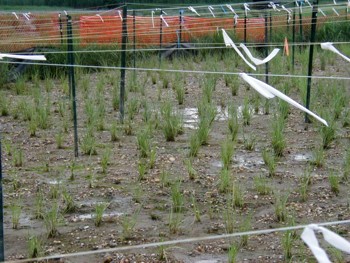|
|
|
|
|
|
|
|
|
||
|
|
Hempstead Harbor Tidal Wetland
Restoration Project
|
|
Laura Schwanof, RLA and Denise Harrington
|
| EEA, Inc. designed a tidal wetland restoration plan for a 5-acre tidal cove in Hempstead Harbor, bordering the south side of the Town of North Hempstead Bar Beach Park. The restoration site represents the first phase of a multi-phased effort encompassing habitat and recreational system improvements associated with a Town Shoreline Nature Trail. Hempstead Harbor is characterized by a tidal range of approximately 7 – 8 feet and is designated by NYS as a Significant Coastal Fish & Wildlife Habitat. This designation is due to its abundant waterfowl population and productivity as a marine finfish nursery and feeding habitat. Consequently, the design incorporated flexibility and environmental benchmarks to ensure that the restoration was successful and the area was not adversely impacted. |
| In addition to the environmental and hydrologic challenges of the site, regulatory permitting and agency coordination proved to be signif- icant challenges. These challenges were due to the fact that the project was spurred by the need for off- site wetland mitigation associated with the cleanup of a State Superfund site located on the west side of the Harbor. Therefore, multiple regulatory agencies were | 
|
|
| involved throughout the design review, implementation, and monitoring phases of this project beyond the normal suite of regulatory agencies involved in NYS tidal wetland restorations. Consequently, this wetland restoration involved not only wetland science focused upon hydrologic and environmental parameters to ensure success, but also drew upon the art of multi-agency juggling during the various phases of the process. | ||
|
Historically, the restoration site supported a thriving salt marsh. Due to several factors (i.e., erosion, sea level rise, etc) this marsh had deteriorated over the past several decades. The project involved removal of approximately 3,150 cu. yds. of mixed debris containing primarily asphalt and concrete rubble along the shoreline and a gravel bar peninsula that was covered by common reed (Phragmites australis). The plan included the re-establishment of smooth cordgrass (Spartina alterniflora) in the intertidal zone and high marsh plantings containing salt marsh cordgrass (S. patens), spikegrass (Distichlis spicata) and black grass (Juncus gerardi). The upland adjacent areas where the Phragmites had been removed was seeded to a native warm season grass mixture. In an effort to re-create a true maritime community, a salt shrub zone was incorporated into the high marsh and various native shrubs were planted in the upland periphery. Project implementation required the development of close partnerships between EEA, the Performing Parties Group and various Trustees, including NOAA/NMFS, New York State Department of Environmental Conservation, USDOI/USF&WS and the Town of North Hempstead. The project was partially funded by the PPG, with matching funds provided by a NOAA Fisheries community assistance grant and in-kind services and support from the Town of North Hempstead. |